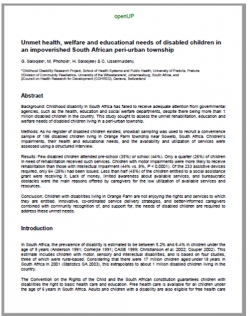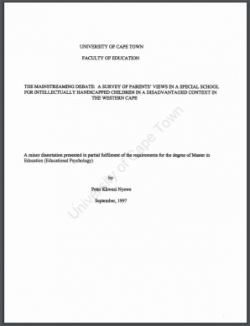Towards the quantification of intellectual disability in children and adolescents in Africa : an exploration of the psychometric properties of the Wessex Behaviour Schedule (WBS) in Khayelitsha, South Africa

Type
Thesis
Authors
Category
ECCE, Foundation, Intermediate, Senior
[ Browse Items ]
Publication Year
2017
Publisher
URL
[ private ]
Tags
Abstract
Background: Intellectual Disability (ID) is important and has a major impact on life, quality of life, mental illness, economic and educational well-being. Little research has taken place in Africa about ID. One of the key challenges is to identify appropriate, useful, and free screening tools that might identify those at risk of ID both for clinical purposes and for prevalence studies. One tool that has been used to investigate the broad category of 'disability' (which includes ID) is the Ten Questions Questionnaire (TQQ). The TQQ has given some rates of 'disability' in lowand middle-income countries (LMICS) in the order of 10-25%. However, no further dissection of ID within the broader category of 'disability' has been performed given that the TQQ was not developed with ID in mind. The Wessex Behavioural Schedule (WBS) is a UK screening tool for functional ability for adults with ID, and therefore seemed an appropriate candidate instrument to evaluate for potential use in Africa. However no psychometric data for the tool were available and no clinical cut-off scores for ID had ever been developed. A broader project using the WBS in Khayelitsha, a township area in Cape Town, South Africa, generated a prevalence rate of 19% 'disability'. The purpose of this study was to explore the psychometric properties of WBS to determine its suitability for use in children and adolescents in a South African setting, and to generate clinical cut-offs to define ID. Methods: The study consisted of a secondary analysis of the data from the broader Khayelitsha prevalence study, which was a cluster randomized door-to-door household survey in Khayelitsha using the WBS. Firstly, data were used to evaluate the internal consistency and to perform factor analysis of the WBS. Secondly, the Minimal Difference Perceived 75% of time (MDP75) approach was used on a subset of 100 randomly selected participants to generate an intellectual disability cut-off score for the WBS. Results: Data were available on 452 children and adolescents aged 5-18 years. The mean age was 10.3 (SD 3.9), 54% were female, over 90% were in school, and 53% had a mother as primary carer. The WBS had good internal consistency (alpha = 0.80) and all items appeared to be worthy of retention. Exploratory factor analysis suggested the WBS to be a multidimensional scale composed of four subscales: conceptual abilities, practical skills, sensory abilities and continence. Even though four expert raters were used for the MDP75 calculation, inter-rater reliability was low-58% (Fleiss kappa = 0.08). It was therefore not deemed appropriate to proceed to further analysis to determine the MDP75 and cut-off values for the WBS. Possible reasons for low inter-rater reliability suggested by the raters included age-based expectations, inclusion of physical disabilities, limited information to make a diagnosis of ID contained in the WBS, and the need to take environmental factors into consideration. Conclusion: The good internal consistency and factor analysis structure of the WBS was encouraging, but the low inter-rater reliability brought into question the usefulness of the WBS in a child and adolescent age group. Whilst the WBS may remain useful in an adult age range, we recommend that a more developmentally-sensitive measure be sought or developed as a screening tool for ID. Keywords: Wessex Behavioural Schedule, children and adolescents, intellectual disability, Khayelitsha.
Description
Thesis (MPhil)--University of Cape Town, 2017
Number of Copies
1
| Library | Accession No | Call No | Copy No | Edition | Location | Availability |
|---|---|---|---|---|---|---|
| Main | 773 | 1 | Yes |



